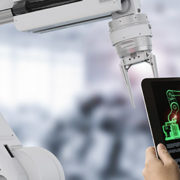Your guide to big data, business intelligence and the modern business
It’s been said that big data is like the new oil boom. Which means that companies who learn how to best refine and apply the lessons derived from the business intelligence data they collect today will almost certainly be tomorrow’s industry leaders. The right data is an enormous advantage out in the business marketplace.
The tools continue to evolve every year, too. Yesterday’s spreadsheet is tomorrow’s BI dinosaur, and technologies like artificial intelligence and machine learning are just starting to make their first heavy inroads into big data collection.
As we move toward the 2020s, we can expect to see incredible new strides in the way data is collected, refined, and put to use. But businesses shouldn’t take that to mean that their contemporaries and potential competitors aren’t already making massive inroads into BI technology and application today.
With that in mind, perhaps it is helpful to spend a little time defining what we mean by “business intelligence,” as well as looking at a few of the different technologies that shape it.
It’s a vast, complex topic, but we’ll do our best to break it up into digestible portions that demonstrate what business intelligence can do for your business now and in the future.
Related: The world’s most valuable resource is no longer oil, but data
What is business intelligence?
CIO defines Business Intelligence (BI) as “leveraging software and services to transform data into actionable intelligence that informs an organization’s strategic and tactical business decisions.”
BI is also often referred to as descriptive analytics or “big data.” Business intelligence is simply collected information from around your business operations or industry that may be strategically useful for your company once digested and organized.
BI can tell a story about the details and trends in your marketplace, your own unique spending habits, your efficiency (or lack thereof), and any one of many, many more measurable categories. It provides a way to measure what is, rather than what seems to be.
Arming your company with the right BI has the power to take you from mid-lister to industry leader, assuming you find the right way to put the data together to move you forward. Arming your company with the right information leads to data-driven solutions and strategies that can direct your company down the best paths to success.
Business intelligence varies in value based on your business’s unique ability to aggregate, digest, and take action with it. There are many examples of how companies have put BI data to work to transform their model. And more companies are strategically employing Big Data every day.
What are BI’s advantages to businesses?
The advantages BI offers businesses of all sizes are probably too many to distill down into anything less than a living, breathing document. This is because BI’s effects are highly dependent on your industry, applications, and specific tools. The advantages are seemingly endless. They’re also growing, changing and increasing in scope all the time.
But we can focus on our top four to get you moving in the right direction:
Better decision making
This may seem obvious, but it needs to be said. Knowledge is power, and businesses who have more information are far more likely to make better decisions as a result. Business intelligence empowers you with the right level and variety of data to make decisions based on multiple parameters, both in the marketplace and in your individual business.
Better internal processes and business efficiency
BI can tell you a massive amount about what your company does well, as well as what it can improve on. It can provide invaluable insight into everything from what truly keeps the lights on in your sales funnel to which customer service areas need more or less of your focus.
Greater market knowledge
BI can tell you a tremendous amount about not only what is selling well for your business in the present but also where your market is headed in the near and even remote future. It can predict coming shortages, rises and falls in demand and even product life cycles.
Smart businesses plan ahead. BI can empower your business to plan ahead with maximum knowledge of where the “honey hole” market shares will be, including potential new revenue streams you may not have considered. It provides powerful information that allows you to take a data-driven approach to growth and expansion.
Serious innovation and competitive advantage
Business intelligence can make your company an innovative leader in your industry. It can suggest new ways of doing things that your competition might not be considering and help you to see potential problems or boons long before the competition catches on.
It can also provide tremendous insight on how your products and services can be improved. While the competition is stuck doing the same old thing, your business could be using BI and the data it cleans to innovate in ways that transform both your business and your industry.
The right BI can take you from middle-of-the-pack Average Joe to prophetic industry frontrunner.
So, let’s take a look at four specific examples of BI at work, and discover what lessons we can glean from each that you can to put to work in your own business.
Real-world BI success stories

– Steven Levitt, Co-author of Freakonomics
Chase-Pitkin Home and Garden fixed their shrinkage problem
The New York-based hardware store was having problems with shrinkage (disappearing inventory). Often goods they ordered from suppliers were disappearing from the store with no record that they had been purchased by customers.
Eventually, the problem made its way to Chase-Pitkin’s CIO, Christopher Dorsey. Dorsey had a brilliant idea for how to approach the problem, one that led to a swift resolution. He used BI software to record the company’s point of sales data for a predetermined amount of time. The company then sifted through this data to see what it might tell them about their shrinkage problem.
It yielded some surprising, enlightening results. Most of the missing items turned out to be power tools. Specifically, smaller tools that were more susceptible to theft due to their size and ease of concealment. Armed with this knowledge, Dorsey rearranged the company’s stores to place these targeted items within better employee view, so that his staff could keep a closer eye on this inventory.

The results? The company saved $200,000 dollars in shrinkage the following year.
It can be incredibly hard to tell where your company is leaking money. That’s where data becomes your greatest ally. You cannot solve a problem until you determine the full scope and details of that problem. Business intelligence tools are a powerful way to gather this knowledge, which you can then put to work to great effect.
As the saying goes, “you don’t know what you don’t know.” BI can balance the scales on theft and help your business thrive in the process.
CVS Health launched a call center pilot program with matchmaking BI
The drugstore chain CVS was having problems with their call center efficiency and ability to help customers effectively. So they hired the services of Mattersight, which specialized in predictive behavioral routing, to automatically connect customers to “like-minded” agents.
Think of it like Match.com for customer service representatives and clients. The idea was to collect data on consumers and sort them into 6 specific categories. Then representatives were scored in different service categories based on a questionnaire to connect those who had the right crossover points with clients they were likely to work well with.
The result? Call times dropped a significant amount. Customer satisfaction with their experience skyrocketed. Eventually, CVS put the software into full production and the call center runs on the software to this day.

It’s hard to know what’s behind efficiency and customer service problems. That’s where data can be so valuable. It can help you discover employee strengths and weaknesses and apply their talents and skills in new and meaningful ways that make the company and its mission more successful.
Coca-Cola’s recipe secret derived from an algorithm (it’s not the recipe you might think)
Consumers don’t generally think of Coca-Cola when they’re pouring a glass of delicious orange juice in the morning. But in reality, their recipe for orange juice is as big a company secret as the original recipe for Coca-Cola itself. The company was facing a common problem that made it hard to standardize its Minute Maid and Simply Orange brands: Mother nature doesn’t care for standardization.
So Coke’s engineers identified more than 600 unique flavor profiles consumers prefer for oranges and built an algorithm that analyzed data on sweetness, acidity, taste, and texture to produce juice that is consistent from batch to batch, no matter what growing season produces the oranges.
The process is incredibly complex and includes collecting satellite imaging to determine picking schedules and a whole host of other data. They call their process Black Book. Without business intelligence and data analytics, the entire process wouldn’t be possible.
The result? Two of the most popular, consistent orange juice brands on earth, worth hundreds of millions of dollars.

The right business intelligence strategies and tools can identify key data to solve problems as complex as the inconsistency of Mother Nature herself. If business intelligence can solve complex problems on this level, imagine what it can do for a host of smaller problems facing businesses every day…
Xerox struggled to keep support centers staffed
Xerox, an international powerhouse in office appliance products and services, had long struggled to staff their support centers. The job was fraught with high burnout rates due to the grinding nature of dealing with unhappy or disenfranchised customers. Xerox’s human resources department had tried everything to turn the attrition tide, to no avail.
Eventually, they turned to Big Data to find a solution. After using business intelligence to sift through a mound of data, they soon discovered that their previous assumption that hiring workers with previous call center experience was totally off base. It turned out that personality was the number-one factor in support center hiring to reduce turnover and increase retention.
By taking personality into account to build stronger teams with a greater sense of mutual respect and partnership, they created a more efficient hiring process that resulted in an impressive 20% reduction in call center employee attrition rates.

What false assumptions could your company be operating under? How off-base are the solutions you’re trying to apply to that stubborn problem that never seems to go away? Business intelligence tools can help analyze huge swaths of data that could reveal secrets to your most pressing problems. These secrets may even be hiding in plain sight, as with Xerox.
If a multinational corporation lacks that kind of perspective without Big Data, it’s likely that your SMB could be suffering similar problems.
Related: 4 ways companies use big data to make smarter decisions
IoT and Big Data
The Internet of Things (IoT) is growing fast. As the use of Internet-connected sensors grows in nearly every industry and product line on earth, a treasure trove of new data is becoming available for businesses to put to use.
The biggest value IoT has to offer is in bringing smarter products to the market. These products will offer greater insight for manufacturers and businesses, as well as greater convenience for users.
When BI meets the IoT, the sky’s the limit in terms of where it could lead. Think of the IoT as the sensors producing the data, and BI as the aggregation and application of that data.
But not all data is the same, nor is it all usable. The trick as the world moves more and more into the IoT revolution will be to harvest and hone the data provided by the billions and billions of sensors in the everyday things all around us.
For businesses, the IoT may give rise to new and innovative ways to track anything from inventory to resource use to workplace behaviors. Analyzing this data can lead to new efficiencies, greater connectivity, and the ability to update supply chains more effectively in real time.
As always, the biggest challenge will simply be in sorting through all the data. That’s where artificial intelligence (AI) and data analytics will open up a whole new horizon for what Big Data can do for businesses.
Related: The Internet of Things 2018 report
Artificial intelligence and Big Data analytics
As we mentioned, data analytics can have human limitations. Even when data is aggregated and sorted out into fairly digestible portions, it can still be very difficult to put to use, particularly if it is large-scale data.
Artificial intelligence and machine learning are already making major strides in this area. Some analysts think it may not be long before AI and machine learning are so powerful that they can actually make recommendations for putting the data they aggregate and digest to best use.
AI has been making its way into business operations for a while now. Many analysts predict that in the coming years AI will become a mainstay in the way businesses perform a number of tasks. But most prevalent is the power that smart algorithms will have on the way companies harness and use data.
Related: 4 business intelligence applications for blockchain
Business Intelligence statistics
Conclusion: The future of business intelligence
As powerful as business intelligence has already become, it may pale in comparison to future BI possibilities. As artificial intelligence and machine learning continue to make their way into BI in the form of new and innovative tools, BI will become increasingly powerful in its ability to transform everything about the way businesses operate.
And with the continued rise of the IoT, the data AI has to work with will continue to aggregate and evolve, leading to more diverse insights about consumers and businesses at every level of the game.
That’s not to count out your IT department, or even your average employee, in putting Big Data and its lessons to use. But we may one day see a time when such processes are practically automated, and the lessons gleaned from crunching data may be available in real time, too.
You need Immybot. Trust us. Our innovative in-house tool is designed to run audits on your business’s software so it can implement updates as efficiently as possible. Once Immybot identifies updates or other maintenance issues, it provides you with simple email notifications that allow you to choose when and how to go about executing the necessary tasks.
This means no more outdated software, and no more poorly timed updates that interrupt business operations. Immybot has much more than this to offer, but we felt we’d be remiss if we didn’t at least mention our favorite in-house piece of software here. Immybot will absolutely transform your business.
Regardless of size, scope or industry, almost every imaginable business can benefit from collecting, measuring, and engaging with business intelligence data. As new tools ramp up, Business Intelligence as a Service (BIaaS) will be a huge and valuable service to SMBs and enterprise-level companies alike.
So what steps are you taking to incorporate BI into your business strategy? Don’t wait until it’s too late to get on the Big Data gravy train … your future success will probably depend on it!
Related: 5 business intelligence trends shaping the future today


























